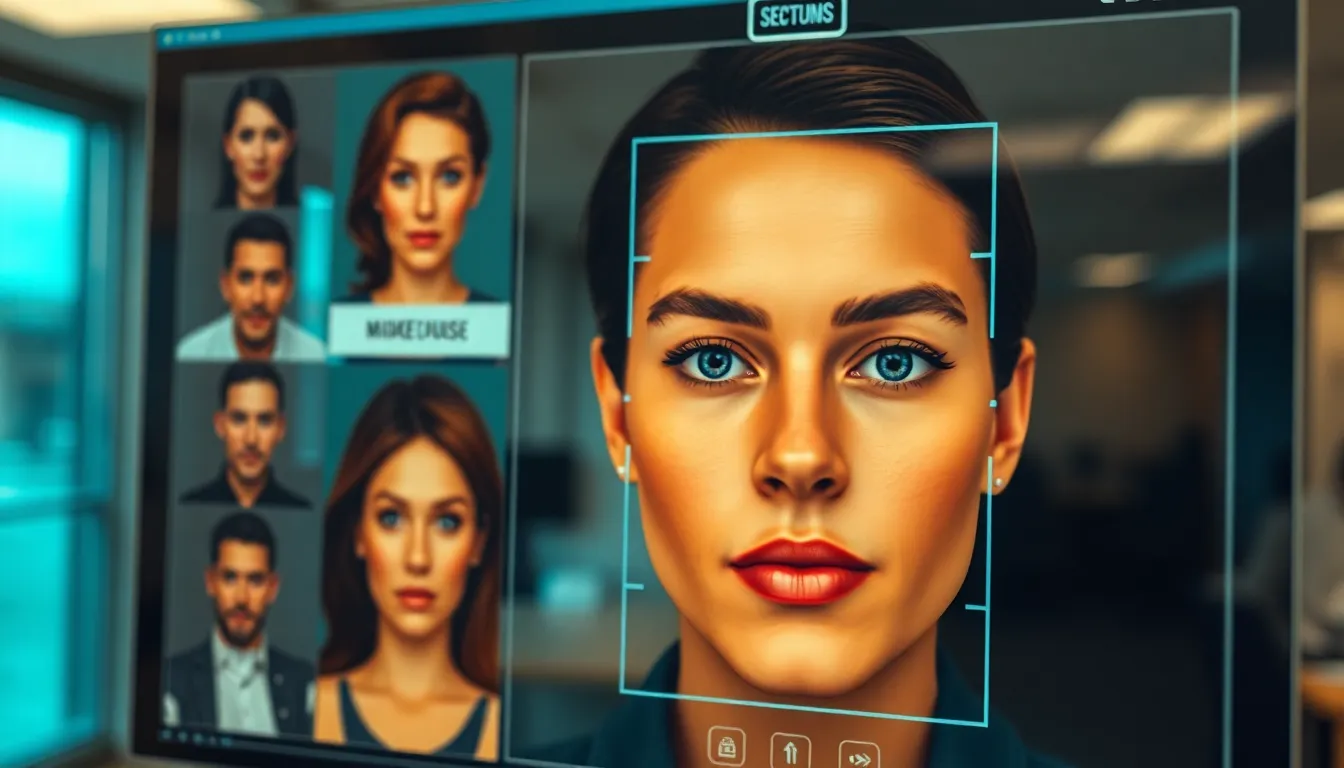Facial recognition software is like having a superpower in the digital age. It can identify people faster than you can say “cheese” and unlock doors with just a glance. Imagine a world where your face is your password—no more forgotten pins or lost keys. Sounds convenient, right?
Table of Contents
ToggleOverview of Facial Recognition Software
Facial recognition software analyzes digital images to identify and verify individuals. The technology relies on patterns in facial features, enabling systems to match faces from images or video against databases. Companies implement this software for various applications, such as secure access or customer identification.
Several techniques underlie facial recognition systems. Deep learning models process data through neural networks, resulting in accurate identification. Algorithms analyze key facial points, such as distance between eyes and shape of the jaw, ensuring efficient comparisons.
Security measures benefit from facial recognition software. Organizations deploy this technology to monitor activities in high-risk areas, improving safety and response to incidents. Law enforcement agencies utilize it to track suspects, identify missing persons, and enhance their investigation processes.
Privacy concerns often accompany facial recognition software. Some critiques focus on data handling and the potential for misuse, highlighting the importance of regulations in its deployment. Striking a balance between benefits and privacy protections remains crucial for widespread acceptance.
The market for facial recognition software continues to expand. Projections suggest significant growth, driven by advancements in artificial intelligence and increased demand for security solutions. Businesses invest in this technology to enhance customer experiences and streamline operations.
Facial recognition has applications beyond security. Retailers use it to personalize services, analyzing shopper demographics to tailor marketing strategies. In healthcare, it assists in patient identification, reducing errors and improving care delivery.
How Facial Recognition Software Works

Facial recognition software relies on advanced technologies to analyze and identify individuals. Understanding the key components enhances comprehension of its functionality.
Key Technologies Involved
Deep learning plays a crucial role in facial recognition systems. Neural networks, particularly convolutional neural networks, excel in processing image data. These networks extract features, such as the distance between eyes or the shape of the jawline, to create unique facial signatures. Another vital technology is image processing, which enhances image quality and captures facial details accurately. Furthermore, biometric sensors gain importance in collecting data from various angles, improving recognition rates. These technologies collectively ensure that facial recognition software operates efficiently and effectively in identifying individuals across various applications.
Algorithms and Data Processing
Various algorithms are employed for facial recognition, each tailored to enhance accuracy. Principal component analysis reduces image dimensionality, aiding in feature extraction. Additionally, support vector machines classify images based on facial features. Real-time data processing enables immediate identification, making technology practical for security and retail sectors. Training models on large datasets enhances algorithmic learning, refining performance over time. Advanced techniques like deep reinforcement learning further optimize algorithms, improving their adaptability in diverse environments. These processing methods create a robust framework, ensuring effective identification and verification.
Applications of Facial Recognition Software
Facial recognition software serves a multitude of important applications across various sectors, enhancing security and improving customer experiences.
Security and Surveillance
Security and surveillance benefit significantly from facial recognition technology. Law enforcement agencies use it to monitor public spaces and track individuals involved in criminal activities. This capability improves overall safety and aids in solving cases by identifying suspects. Security systems in buildings utilize facial recognition to grant access, enabling authorized personnel while deterring unauthorized entry. Additionally, airports and transportation hubs rely on this technology to enhance passenger security and streamline boarding processes. The accuracy and speed of facial recognition software help reduce risks in high-stakes environments, providing real-time monitoring and alerts.
Marketing and Customer Insights
Marketing uses facial recognition software to gain insights into consumer behavior. Retailers implement this technology to analyze customer demographics and preferences, facilitating targeted advertising strategies. Stores can track foot traffic patterns and assess customer engagement with products, enhancing overall shopping experiences. Personalized promotions and tailored services become possible, as retailers utilize data derived from facial recognition to refine their offerings. Additionally, event organizers employ facial recognition to enhance attendee experiences by identifying guests quickly and providing customized engagement. This integration fosters greater customer loyalty and satisfaction, ultimately driving revenue growth.
Pros and Cons of Facial Recognition Software
Facial recognition software presents both significant advantages and pressing challenges. Understanding these aspects is essential for evaluating its impact.
Benefits to Society
Facial recognition software enhances security in public spaces and prevents criminal activities. Law enforcement agencies track suspects more effectively, reducing response times. This technology plays a role in identifying missing persons, potentially reuniting families. Retailers benefit from improved customer experiences through personalized services. Event organizers streamline guest management and create better engagement opportunities. With advanced authentication methods, businesses strengthen security protocols, minimizing unauthorized access. Overall, these benefits contribute positively to societal safety and convenience.
Ethical Concerns and Privacy Issues
Concerns about privacy arise as facial recognition software becomes more prevalent. Individuals may feel uncomfortable being monitored in public areas without consent. Misuse of data poses significant risks, including unauthorized access and potential for discriminatory practices. Lack of regulation often leaves gaps in accountability for organizations using this technology. Public trust diminishes if transparency isn’t prioritized. Ethical implications also include the potential for wrongful identification, affecting innocent individuals. Balancing security benefits with personal privacy rights remains a critical challenge for lawmakers and society.
Future Trends in Facial Recognition Software
Increasing reliance on facial recognition software is evident across numerous sectors. Enhanced technologies such as artificial intelligence and machine learning drive advancements in accuracy and speed. Implementing more sophisticated algorithms enables systems to learn and adapt to new data quickly, ensuring continuous improvements.
Further developments in privacy-preserving techniques would address the ethical implications often associated with this technology. Protecting user data while enhancing capabilities remains a priority. Innovations in decentralized systems could allow for identity verification without central data storage, reducing privacy risks.
Integration with other biometric systems suggests a comprehensive approach to security. Combining facial recognition with voice, fingerprint, or iris recognition leads to multi-factor authentication. This integration increases overall security and builds trust among users.
Expanding use cases also indicates a shift towards everyday applications. The retail industry may leverage facial recognition more for personalized marketing and customer engagement, enhancing shopping experiences. Hospitals might implement improved patient identification systems, enabling better healthcare delivery and streamlined admission processes.
Emerging regulations and standards will play a crucial role in shaping the future landscape of facial recognition software. Consistent guidelines will promote responsible usage and help counteract potential misuse. As public awareness grows, transparency in data handling practices becomes essential for maintaining user confidence.
Adaptions in hardware, such as advanced cameras and sensors, contribute to the effectiveness of facial recognition systems. These improvements facilitate better recognition rates in various environments, including low-light conditions. As technology evolves, the landscape of facial recognition will shift, producing innovative solutions that balance security and user privacy.
Facial recognition software is transforming how society approaches security and personalization. Its rapid advancements promise a future where identification is seamless and efficient, enhancing user experiences across various sectors. However, as its adoption grows, so do the ethical dilemmas surrounding privacy and data protection.
Balancing the benefits of this technology with the need for accountability is crucial. Stakeholders must work together to establish regulations that protect individual rights while embracing innovation. The path forward will likely involve continuous improvements in technology and a commitment to responsible usage, ensuring that facial recognition serves as a tool for progress rather than a source of concern.










